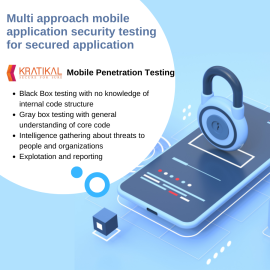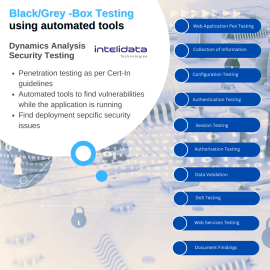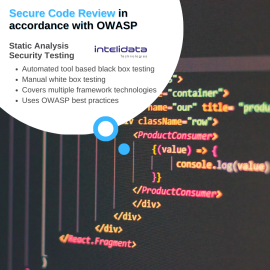Description
Overview
Web-based application Penetration testing is the process of simulating a hacker-style attack on your web app in order to detect and analyze security vulnerabilities that an attacker could exploit. Web applications are critical to business success and an appealing target for cybercriminals. Web application penetration testing is the proactive identification of vulnerabilities in applications, such as those that could result in the loss of sensitive user and financial information.
Methodology
A comprehensive approach to performing penetration tests that not only finds security vulnerabilities but also business logic vulnerabilities, as well as security checklists based on industry standards such as OWASP10, SANS25, OSSTMM, and so on. Kratikal provides on-premises and off-premises application security services with the following roadmap, based on years of experience across application threat surfaces such as online, mobile, and cloud.
Types of Testing–
-
Black Box – Black Box, often referred to as behavioral testing or external testing, is a form of software testing technique wherein no prior knowledge of the internal code structure, implementation specifics, or internal routes of an application is necessary. It focuses on the application’s input and output and is entirely dependent on the specifications and requirements for the software.
-
Gray Box Testing – Gray box testing, which combines black box and white box testing, is a software testing approach used to test an application while only having a general understanding of its core code. It searches for and identifies context-specific errors that the application’s poor code structure has produced.
-
White Box Testing – White Box testing examines a software’s underlying structure, coding, and architecture in order to validate the input-output flow and improve the application’s design, security, and utility. Testing of this kind is sometimes referred to as internal testing, clear box testing, open box testing, or glass box testing because testers can see the code.
Security Testing Approach
-
Information Gathering – Reconnaissance, or information collection, is one of the most crucial responsibilities of an application penetration test. The first stage of a web application penetration test is all about learning as much as you can about the target application. Several instances of testing Perform search engine reconnaissance and discovery to look for information leaks, enumerate apps, and fingerprint apps. Find the entry point for the application.
-
Configuration Management – Nearly as crucial as performing application security testing is comprehending the deployed configuration of the server or infrastructure that runs the web application. Despite the diversity of application platforms, a number of fundamental platform setup difficulties, such as how an unsecured program can infect the server (insecure HTTP methods, old/backup files), can put the application at risk. TLS Security, App Platform Configuration, File Extension Handling, and Cross-Site Tracing are a few examples. HTTP methods, file permissions, and strong transport security are all put to the test.
-
Authentication Testing – Authentication is the process of attempting to confirm the sender of a communication’s digital identity. The most prevalent illustration of such a process is the log-on process. Testing the authentication schema requires knowledge of how the authentication procedure operates and the use of that knowledge to subvert the authentication mechanism. Poor lockout mechanisms, circumventing authentication schemes, browser cache vulnerabilities, and inadequate authentication in other channels are a few examples.
-
Session Management – Session management is the collective term for any controls in charge of overseeing a user’s stateful activity with the web application they are using. Everything from user authentication to the general logout process is included here. A few instances include session fixation, cross-site request forgery, cookie management, session timeout, and testing the functionality of the logout process.
-
Authorization Testing – Since authorization comes after successful authentication, the pen tester will validate this after establishing that they have authentic credentials linked to a clear-cut set of roles and privileges. Insecure direct object references, privilege escalation, and getting around permission rules are a few examples. Permission testing requires comprehending the operation of the authorization system and using that understanding to circumvent it.
-
Data Input Validation – The most prevalent security vulnerability in online applications is the failure to fully verify input from the client or the environment before using it. This vulnerability affects web programs and can lead to buffer overflows, cross-site scripting, SQL injection, interpreter injection, attacks on locale/Unicode, file system vulnerabilities, and more.
-
Testing for Error- Handling – During a web application penetration test, we frequently come across a plethora of error codes released by applications or web servers. A specific request, created manually or with the aid of tools, might be used to display these issues. Due to the abundance of data they provide about databases, security holes, and other technological elements directly related to online applications, these codes are very helpful to penetration testers. Analyzing error codes and stack traces are only a couple of examples.
-
Testing for Business Logic – A vulnerability known as the “Think Outside the Box” vulnerability depends on the penetration tester’s knowledge and abilities because a vulnerability scanner cannot find it. In addition, this kind of vulnerability is sometimes one of the hardest to find because it is application-specific, but it is also one of the most damaging to the program if it is exploited. Integrity checks, process time, uploading an unexpected file type, and the capability to forge requests are a few examples.
-
Client-Side Testing – Client-side testing focuses on client-side code execution, which is typically carried out directly within a web browser or a browser plugin. When code is run on the client side, it is different from when it is run on the server and results in content being returned. Several instances include the use of JavaScript, client-side URL redirection, cross-origin resource sharing, and manipulation.
-
Denial-of-Service (Optional) – Attacks that cause a denial of service (DoS) are intended to restrict authorized users from using a resource. A malicious user floods a target system with enough traffic to prevent it from serving its intended users in a denial of service (DoS) attack. during this stage. Testing will be focused on application layer attacks on availability that may be executed by a single malicious user on a single system.
-
Reporting – The reporting step’s objectives are to present, rank, and prioritize findings as well as to give project stakeholders a concise, actionable report with accompanying data. At Kratikal, we consider this to be the most crucial stage, so we take great care to ensure that we have adequately communicated the significance of our findings and service.










Description
Kratikal is a CERT-In Empanelled cyber security solutions provider. It is the trusted partner for enterprises and individuals, seeking to protect their brand, business and dignity from baffling cyber attacks. Kratikal has carved out a position in the cyber security space, earning the trust of some of the world’s most prestigious businesses, from various industries such as Fintech, Telecom, Healthcare, E-commerce, and others. Our trained security professionals assist in finding vulnerabilities, by applying worldwide compliances such as ISO 27001 and SOC2.
We have been involved in the design, and implementation of information security management systems since the time standards were adopted by the industry. We are experts in conducting a thorough examination of a company’s IT infrastructure and providing effective cyber security solutions.